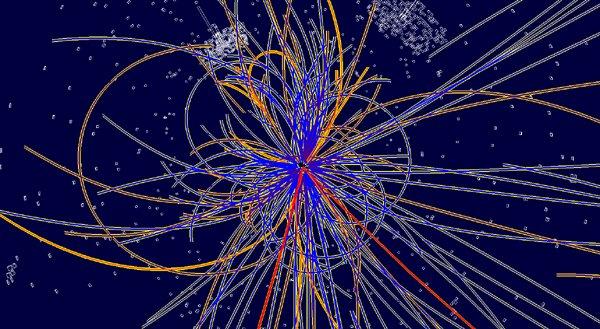ISU physicists make impact on CERN particle discoveries

A simulation of evidence for the Higgs boson. Scientists said July 4, 2012 that they had discovered a new particle whose characteristics match those of the Higgs boson, the most sought-after particle in physics, which could help unlock some of the universe’s deepest secrets.
July 12, 2012
ISU researchers have had a special role in possibly the biggest physics breakthroughs in the last 50 years.
Since 1999, the ISU physics and astronomy department has been working with the European Organization for Nuclear Research (more commonly known as CERN, from the French) to make new discoveries in physics.
Hundreds of feet under ground at the border of France and Switzerland lies CERN’s Large Hadron Collider, the world’s largest particle accelerator. At the collider, physicists accelerate subatomic particles to near the speed of light and then have the particles collide.
Since mass and energy are related to each other, these collisions have enough energy to create mass. After each experiment, scientists analyze the data from the collisions to determine what was created. Within the LHC is the ATLAS, or A Toridal LHC Apparatus, detector, which has been in operation since 2008.
On July 4, scientists at CERN announced they had found a particle that is “consistent” with the Higgs boson. The Higgs boson is a fundamental particle in physics which makes up the Higgs field — an even distribution of bosons throughout the universe.
At Iowa State, a team of students and professors worked with ATLAS to give support and analyze data. Jim Cochran, professor of physics and astronomy, said the team spends about half their time doing support for experiments. This includes “making sure things are running, working on software to deal with all the data coming out, that kind of stuff.” The other half of the time, they are analyzing data from experiments.
This data not only helps the science community as a whole, but also the students. In the past year, three ISU graduate students, each spending several years as residents at CERN, have earned Ph.D. degrees using ATLAS data, and many more undergraduate students have been involved in Ames.
“We have one student who was working on the Higgs, though her work wasn’t as much a part of this thing as it will be in the paper that comes out in July,” Cochran said.
In addition to the research, Iowa State’s physics and astronomy department has provided ATLAS with leadership in a variety of areas. Assistant professor Chunhui Chen has been awarded a U.S. ATLAS Fellowship for 2012; professor Soeren Prell is the chairman of the U.S. ATLAS Speakers Committee; postdoctoral associate Arantxa Ruiz Martínez is the convener of one of the ATLAS physics analysis subgroups; and Cochran was recently appointed as the deputy operations program manager for the U.S. portion of ATLAS.
The next step for ATLAS is to confirm that the particle is the Higgs boson.
“We’ve clearly found something,” Cochran said. “It’s a beautiful thing. But we’re not absolutely sure it’s the Higgs. It certainly looks like it could be; it has the right properties.”
The Higgs boson particle and its field are just part of the Standard Model in physics, which explains the different forces and interactions between particles. The Standard Model says the Higgs boson gives other particles their mass and explains why some subatomic particles, such as quarks, have heavy masses, while photons are massless and travel at the speed of light.
Before the Higgs mechanism, first proposed by University of Edinburgh physicist Peter Higgs and his team in 1964, the Standard Model lacked an explanation for how most elementary particles gain mass.
“The [pre-Higgs] concept is that all of space is filled with ether. For years people wondered how light traveled through space. Obviously it traveled through something,” Jim Cochran said. “Before they understood how things worked, they would say, ‘Ah, there’s ether.’ They were able to show that it wasn’t true.”
The Higgs theory explains that, instead of “ether,” everything travels though the Higgs field, and all particles except for photons interact and gain mass from the field.
The discovery of this particle should lead to a stronger Standard Model of physics and a deeper understanding of interactions at the subatomic level.
“The least biggest thing we’ve possibly found is the Higgs, but that’s still a pretty big deal,” Cochran said. “It’s hard to predict the future.”






